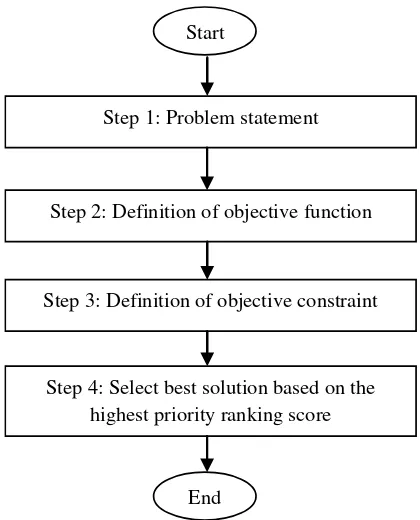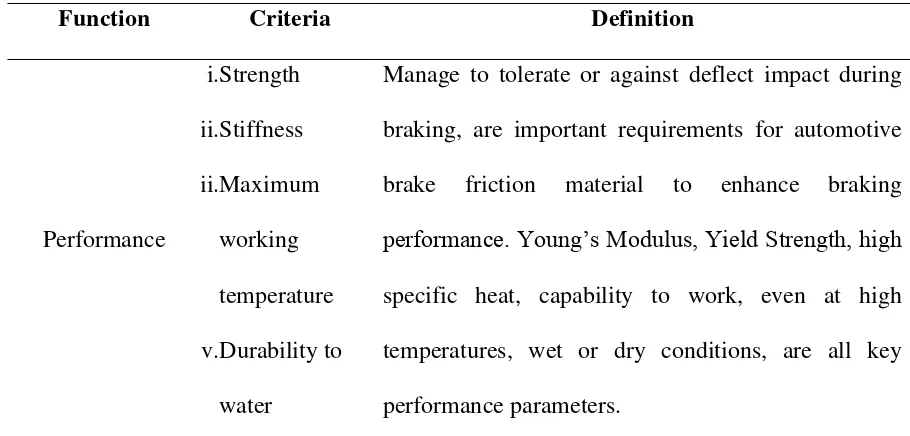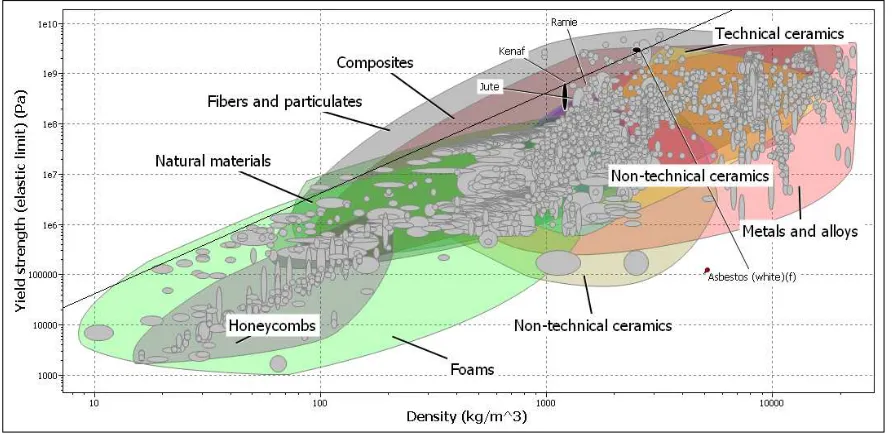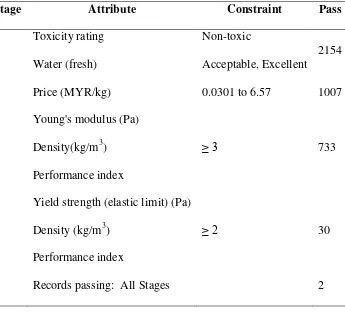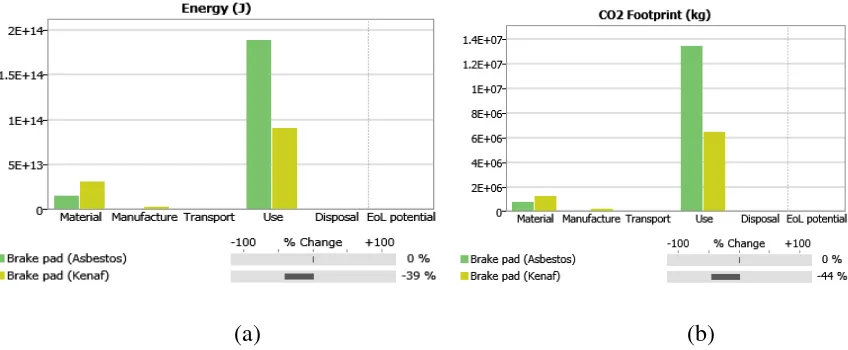Pre-Materials Selection for Eco-Aware Lightweight Friction Material
Ashafie Mustafab, Mohd Fadzli Bin Abdollaha,b,*, Nurhidayah Ismaila,b, Hilmi Amiruddina,b, Noritsugu Umeharac
a
Centre for Advanced Research on Energy, Universiti Teknikal Malaysia Melaka, Hang Tuah Jaya, 76100 Durian Tunggal, Melaka, Malaysia.
b
Faculty of Mechanical Engineering, Universiti Teknikal Malaysia Melaka, Hang Tuah Jaya, 76100 Durian Tunggal, Melaka, Malaysia.
c
Department of Mechanical Science and Engineering, Graduate School of Engineering, Nagoya University, Furo-cho, Chikusa-ku, Nagoya 464-8603, Japan.
*E-mail: [email protected]
Abstract. In the automotive industry, non-asbestos based components, such as brake
pads, have been in high demand due to environmental and human health concerns. Therefore, the purpose of this study is to design and select an alternative friction material, which is desired to eco-aware lightweight, cost effective, and non-toxic. This will be accomplished using Cambridge Engineering Selector (CES) Edupack software, embedded within an Eco-Audit Tool. The results show that Kenaf, which is a commodity plant in Malaysia, is the most suitable alternative friction material that passes all of the design stages and consumes less energy, compared to asbestos and other potential materials.
1.0 INTRODUCTION
In order to reduce weight, there are two important methods. One of these methods is to redesign the selected parts to optimize their structure. The other method is to replace traditional materials with lightweight materials, such as aluminium alloy, polymer, or composites [1, 2]. Of these two methods, material replacement is generally more effective in achieving a lightweight than structural modification.
An automotive brake functions by converting the vehicle’s kinetic energy into heat
energy. The two currently used types of automotive brake friction material are semi-metallic and non-asbestos organic (NAO) [3,4]. Automotive brake friction material (i.e., for brake shoes and brake pads) is combination of several materials with unique complex compositions, that are known as binder, reinforcing fiber, filler, and friction modifier [5]. Desirable performance requirements for automotive brake friction materials include stability and a high friction coefficient (µ) (according to SAE J899a), reduced vibration (judder) and noise, environmentally friendly, resistance to heat, wear, water, and oil, does not damage the brake disc, and has the capability of being manufactured with consistency and a reasonable cost [2,4,6-7].
The CES EdupackTM (developed by M. Ashby and co-workers at Cambridge University, UK [16]), is a software that provides a database of >3000 materials and process information that help in selecting materials and processes to meet the desired complex design requirements. The optimal potential materials can be ranked using the desirable criteria or properties that meet the design’s requirement. This software is also provided with
Eco-audit, which is able to calculate the embodied energy used and the CO2 produced during five key life phases of a product (i.e., material, manufacture, transport, use, and end of life) [17]. The results produced can be used for targeted environmental impact minimizing parameters.
Thus, the aim of this paper is to select an alternative friction material, which is eco-aware lightweight, cost effective, and non-toxic using a systematic approach. This paper is structured following the basics of the CES Edupack selection material approach, with a short overview of the material’s selection; design requirement; results of the preliminary material’s selection; comparison of the ranked materials series, obtained via eco audit tools; and selection of the best alternative material.
2.0 MATERIAL SELECTION STEPS
desirable requirement for all automotive friction material, because during the braking process, the friction material is pressed against a rotating brake disc or drum and subjected to wear [20]. If the friction material has a high wear rate, it must be changed more frequently, thus increasing the cost to maintain the performance of the vehicle. Due to kinetics and pressure, heat is produced during braking. Normal operating temperatures recorded usually range from 200-2500C, and 3700C was registered for the front wheel disc pads [21] of passenger cars. For a normal passenger car, typical pressure applied during braking ranged from 0 to 4MPa [22,23]. For safety, a modern brake system is designed for an exerted pressure on the pads of approximately 0-10MPa.
Developing a successful friction material requires the best balance of factors that yield acceptable performance, cost, and environmental friendliness. Friction materials were generally developed through trial and error, coupled with previous experience of the manufacturer. However, mathematical methods were suggested for evaluation and optimization, such as grey relational analysis [9] and single-criterion extension evaluation method [24]. The correct combination and composition of materials and particle sizes can enhance the tribological performance of the braking interface [25,26].
1. Problem definition– product characteristics a. Function – purpose of the product
b. Objective of the selection – eco-aware lightweight friction materials
c. The constraints – stage limit properties for material requirements (criteria) must be met.
2. Objective function– by example, to minimize weight and cost of current components, with the capability to be normally functional, with less environmental impact.
3. Constraints – stage limit for material selection must be met. This is normally achieved by ‘performance indices’ and ‘attributes limit’. Performance indices for this
study were derived from an equation that affects performance material properties, while attribute limits, where maximum and minimum values or properties, were filled for the overall assessment of the new design’s characteristics, such as durability for water and toxicity.
4. Implementation – of the stage constraints requirement for material selection using CES Edupack material’s selection charts. In this study, several material charts were
plotted using material properties (or combinations) against each other on logarithmic axes. Performance indices and attributes were used in these charts to identify potential material candidates. Potential materials that met all of the design constraints (stage limits) were evaluated again by Eco-audit to calculate embodied energy and CO2 footprint produced.
FIGURE 1. CES Methodology for material selection
3.0 MATERIAL SELECTION FOR ECO-AWARE LIGHTWEIGHT FRICTION
MATERIALS
In order to illustrate the material selection approach, straight forward examples were considered. The overall selection process of new eco-aware friction materials is described as follows:
Step 1 - Problem definition.
Asbestos, proven as a human carcinogenic, production for raw materials was banned. Asbestos is a compulsory material added to automotive friction materials. In order
Start
Step 1: Problem statement
Step 2: Definition of objective function
Step 3: Definition of objective constraint
Step 4: Select best solution based on the highest priority ranking score
for a safer alternative, developing a NAO is the best solution for replacing asbestos in automotive friction materials.
Step 2 - Definition of objective function.
The objective of this project is to define eco-aware lightweight potential materials, with a capable functional performance, easily available, and at a reasonable cost, using asbestos as a datum. The alternative materials selected must be on a par or have better properties than asbestos, in order to be proven as valid alternatives.
Objective function can be described as the requirements that selected materials must meet, added to the new requirements of an eco-aware lightweight friction material for this study. For example, function stages for new eco-aware lightweight friction materials selected for this study are performance; which is identified through a review of material specifications including, weight, and standard operation performance based on SAE edge code on tribological performance, disposal, environment, and cost. Objective function and specifications for the designed eco-aware lightweight friction material are shown in Figure 2 and elaborated upon further in Table 1.
Step 3 - Definition of objective constraint.
and performance indices slope (M) are included, aligned with datum by considering Equations (1) and (2);
C
E 3log log
log (1)
C
log log
2
log (2)
FIGURE 2. New automotive eco-aware lightweight FMs design specifications
TABLE 1. Function and criteria desired for the eco-aware lightweight friction material
Function Criteria Definition
Performance i.Strength ii.Stiffness iii.Maximum working temperature iv.Durability to water
Manage to tolerate or against deflect impact during braking, are important requirements for automotive brake friction material to enhance braking performance. Young’s Modulus, Yield Strength, high
specific heat, capability to work, even at high temperatures, wet or dry conditions, are all key performance parameters. Eco-aware lightweight friction material Performance Disposal Weight Environment Cost Standard Stiffness Weight Strength SAE J886a
Reuse or recyclability
Durability- excellent to water
Manufacturing Raw material Safe for disposal
Non-toxic materials
[image:9.612.76.531.463.681.2]Lightweight i.Density
To minimize the weight of components and maintain the required structural strength, and be safe for functional operation. Capability to reduce weight for fuel efficiency.
Product cost
i.Raw material cost
Minimize product cost and be easily available
Environmentally friendly
i.Non-toxic ii.Less energy
and CO2
For the environment and be potentially safe
Step 4 - Selection material on CES Edupack.
FIGURE 3. Plotted graphical material for Young’s Modulus (Pa) against Density (kg/m3)
[image:11.612.85.531.392.609.2]Maximum service temperature materials followed the universal properties database provided by CES Edupack, because the remaining materials were asbestos and Kenaf fibers. Summary results for all design stages are shown in Table 2.
TABLE 2. Summary results for all design stages using CES Edupack.
Stage Attribute Constraint Pass
1 Toxicity rating Water (fresh)
Non-toxic
Acceptable, Excellent
2154
2 Price (MYR/kg) 0.0301 to 6.57 1007
3 Young's modulus (Pa) Density(kg/m3) Performance index
≥ 3 733
4 Yield strength (elastic limit) (Pa) Density (kg/m3)
Performance index
≥ 2 30
5 Records passing: All Stages 2
impacts and other information about the given material’s process. Figures 5a and 5b show the comparisons for potential material’s embodied energy and CO2 footprint, which could be used to identify materials producing less impact to the environment. Materials that met these requirements were ranked for being lightweight, eco-aware constraint for the selection of new eco-aware lightweight materials to replace asbestos in automotive brake friction materials.
[image:13.612.96.520.282.457.2](a) (b)
FIGURE 5. Eco-audit results between materials for (a) energy and (b) CO2 footprint
gap already contains a big difference. Therefore, Kenaf was chosen as the material that had less impact to the environment.
4.0 CONCLUSION
Pre-selection for an alternative material to asbestos, to be included as an automotive friction material, was performed using CES Edupack software, based on a formulated design and its requirements. Through all of the criteria and the constraints, Kenaf fibers were identified as being the best material of all, which pass all the design requirements. This was proved using Pugh’s method, where the results show a promising potential for
Kenaf fibers by capability on eco-aware with reduction impact to the environment, lightest, and the cheapest.
ACKNOWLEDGMENTS
REFERENCES
1. Y. Zhang, X. Lai, P. Zhu, W. Wang. Lightweight design of automobile component using high strength steel based on dent resistance. Materials & Design 2006, (27):64
2. M.F.B. Abdollah, R. Hassan.Preliminary design of side door impact beam for passenger cars using aluminium alloy. Journal of Mechanical Engineering and Technology 2013, (3):11
3. D. Chan, G.W. Stachpwiak, Proceeding of the Institution of Mechanical Engineers, Part D : Journal of Automobile Engineering 218, 2004. p. 953-966.
4. P.J. Blau, Compositions, functions, and testing of friction materials and their additives. OAK Ridge National Laboratory Report ORNL/TM 2001/64. 2001
5. M. Eriksson, F. Bergman, S. Jacobson. Surface characterization of brake pads after running under silent and squealing conditions. Wear 1999, (232):163.
6. F. Bergman, M. Eriksson, S. Jacobson. Influence of disc topography on generation of brake squeal.Wear 1999, (299):621.
7. S. Kim, H. Jang. Friction and Wear of friction materials containing two different phenolic resin reinforced with aramid pulp. Tribology International 2000, (33):477. 8. C. Ramazzini, Call for an international ban on asbestos. Environment Resolution May
2000, (83):79.
10.B.F. Yousif, U. Nirmal, K.J. Wong. Three-body abrasion on wear and frictional performance of treated beselnut fiber reinforced epoxy (T-BFRE) composite. Materials & Design 2010, (31):4514.
11.S.A.R. Hashmi, U.K. Dwivedi, G. Navin. Graphite modified cotton fiber reinforced polyester composites under sliding wear conditions. Wear 2007, (262):1426.
12.B.A. Acha, N.E. Marcovich, M. Reboredo. Physical and mechanical characterization of jute fabric composites. Journal of Polymer Science (2005), 262:736.
13.Q. Liu, M. Hughes. The fracture behavior and toughness of woven flax fiber reinforced epoxy composite. Composites Part A: Applied Science and Manufacturing 2011, (39):1644.
14.N. S. M El-Tayeb. A study on the potential of sugarcane fibers/polyester composite for tribological applications. Wear 2008, (39):223.
15.M. Yunhai, S. Shenglong, T. Jin, Y. Wei, Y. Yazhou, Z. Jiang. Effects of bamboo fibers on friction performance on friction materials. Journal of Thermoplastic Composite Materials 2010, (26):845.
16.M.F. Ashby, D. Cebon, Teaching engineering materials: the CES Edupack. Engineering Department, Cambridge University. 2007. p.1-13.
17. J. O’Hare, E. Cope S. Warde, Five steps to eco design, improving the environmental
performance of products through design. Granta Design Limited. 2011. p. 1-12.
19.S. Katsuhiro, G. Akira, Y. Satoshi, A. Yuichi, N. Koji. Development of brake friction material, Honda Research and Development Co. Ltd. 1993. p. 149-161.
20.Dr Katsuyoshi Kondoh. Powder Metallurgy. InTech. 2012.
21.M.G. Jacko, S.K. Rhee. Brake linings and clutch facing in: Grayson, M. (ed.), Encyclopedia of Composite Materials and Component, John Wiley and Sons, 1995. p. 144-154.
22.N.M. Kinkaid, O.M. O'Reilly, P. Papadopoulos. Automotive disc brake squeals. Journal of Sound and Vibration 2003, (267):105.
23.G. Cueva, A. Sinatora, W.L. Guesser, A.P. Tschiptschin. Resistance of cast irons used in brake disk rotors. Wear 2003, (255):1256.
24.R. Yun, Y. Lu, P. Filip, Performance and evaluation of eco-friendly brake materials. Tribology International 2010, (43):2010.
25.N.S. M. EL-Tayeb, K.W. Liew. On the dry and wet sliding performance of potentially new frictional brake pads materials for automotive industry. Wear 2009, (266):275. 26.K.S. Bhabani, P. Amar, D. Nandan, R. Prasanta, S.T. Bharat. Investigations on
